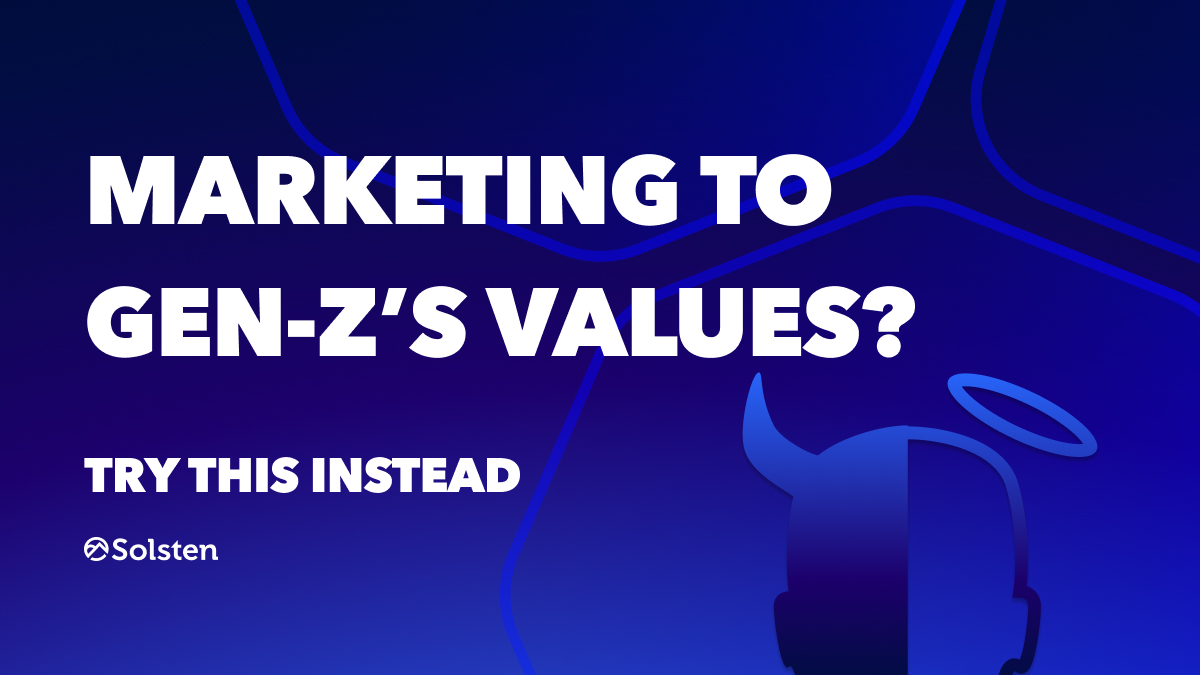It takes Gen Z consumers 1.3 seconds to lose interest in an ad. People have circulated this stat on LinkedIn so many times that it has lost its impact. Instead of taking it seriously, most marketers decide to rationalize: “Well, most ads are bad. The good ads that we make will stand out.”
And they’re right! Just like previous generations, Gen Z audiences are not immune to marketing. The right ads work on them, just like they do Baby Boomers. But here’s the million-dollar question: What makes an ad “right” for Gen Z?
The knee-jerk response in marketing meetings everywhere is predictable: “We need to appeal to Gen Z’s values!” What comes next is usually a flurry of buzzwords — “authenticity,” “social responsibility,” “mental health,” and the perennial favorite, “community.”
While this is a well-intentioned approach, it ignores a few dark realities about the current state of marketing:
Only 38% of marketing leaders express confidence in knowing their customers’ top motivators. Even more concerning, 72% admit they don’t even know how to define those motivators.
This knowledge gap is especially clear when advertising to Gen Z. These young people aren’t just playing games, they’re changing the whole gaming world. They’re not just consumers, they’re influencers, creating content and driving the emerging trends that are shaping gaming. Yet, marketers continue to try fitting them into boxes labeled with oversimplified “values.”
To create ads that truly connect with Gen Z, we need to dig deeper. We need to understand the reasons behind their behavior. We need to look at their motivations.
So, how do we do that?
In this article, we’ll look at the real drivers behind Gen Z’s advertising preferences. By understanding the complex psychological landscape — from anxiety and status-seeking to competitiveness and the need for novelty — we can move beyond superficial appeals to “values.” With these insights, we can create ads that genuinely connect with one of the most diverse generations.
Each trait in this article is measured on a scale from 0-100, offering a quantitative insight into Gen Z psychographics. You can learn more about Solsten’s methodology and data collection here. And if you’d like to gain full access to all of Solsten’s psychological data across generations (and learn how it can optimize your marketing and product design) feel free to reach out.
The “Values” Misconception
Many approach their Gen Z marketing strategies with a simplistic understanding of values, focusing on surface-level concepts like “community.” Yes, community engagement is high among Gen Z. However, treating it as a core value misses the motivations driving this behavior.
The truth is, what many marketers label as “values” are often just preferences or trends. True values run deeper and are more nuanced than the buzzwords commonly thrown around in marketing meetings.
What Marketers Miss About Gen Z Values
Solsten’s data reveals some seemingly conflicting traits in Gen Z gamers:
- High community engagement alongside high status orientation: Gen Z males value community with a score of 69. They also show high status orientation with a score of 61.
- Strong competitive drive: Gen Z shows high competitive affectivity (females score 49, males score 43). This is seemingly at odds with community-focused values.
These apparent contradictions point to a more complex value system than marketers often acknowledge. Gen Z’s values aren’t simple, one-dimensional concepts. Instead, they’re complex and often expressed through motivations and preferences rather than stated beliefs.
This data, provided by Solsten’s ongoing psychological assessment, offers a level of insight not typically available through traditional market research. It highlights the need for a more nuanced understanding of Gen Z’s psychological landscape.
Redefining Values for Gen Z Gamers
To truly understand Gen Z’s values, we need to go beyond surface-level trends. We need to look at the psychological factors driving their behavior. Our data shows:
- High levels of anxiety: Gen Z females score 64 and males score 53 in anxiety.
- Increased neuroticism: Gen Z scores higher in neuroticism (61 for females, 50 for males) compared to other generations.
- Proneness to boredom: 56% of Gen Z females and 39% of males report high levels of boredom.
These psychological factors aren’t separate from Gen Z’s values — they’re expressions of deeper, more fundamental values. For instance, high anxiety levels might reflect a value placed on security and stability. Boredom, on the other hand, could indicate a deep-seated value for novelty and stimulation.
Staying current with these evolving psychological factors requires continuous, in-depth analysis. Companies of all sizes are achieving this by using market research tools like Navigator by Solsten.
The Real Keys to Gen Z Marketing
Instead of focusing on superficial interpretations of values, marketers should:
Address Anxiety and Vulnerability
Products and marketing campaigns that offer escapism, stress relief, or a sense of control may resonate more strongly with Gen Z’s underlying need for security.
Leverage the Competitive Spirit Within Community
Recognize that community and competition aren’t mutually exclusive. Gen Z values both, suggesting a preference for collaborative competition or competitive collaboration.
Combat Boredom While Fostering Engagement
Gen Z’s high boredom scores suggest a value for constant stimulation and novelty. This doesn’t contradict community values but indicates a preference for dynamic, ever-evolving social spaces.
Why Traditional Approaches Fall Short
Only 40% of marketing leaders believe their personas accurately represent their actual customers. This discrepancy is particularly problematic with Gen Zers, whose traits and preferences evolve rapidly. Static, oversimplified understandings of values often lead to misguided marketing efforts that fail to capture the psychological nuances of the younger generation.
Want dive into your customers’ psychology? Check out our step-by-step tutorial and start turning insights into action today.
Practical Strategies for Crafting Gen Z-Resonant Ads
Understanding the psychological drivers of Gen Z is just the first step. Translating these insights into effective advertising strategies is where the real challenge — and opportunity — lies. Here are the best ways to create ads that will resonate with and reach Gen Z:
Embrace Micro-Content for Macro Impact
Gen Z’s high boredom scores (56 for females, 39 for males) indicate a need for constant stimulation. Create a series of interconnected micro-ads — 5 to 15 seconds each — that tell a larger story. This approach caters to shorter attention spans while rewarding continued engagement.
Example: Develop a series of short form video ads showcasing different product features, each ending with a cliffhanger that leads to the next ad.
Highlight Skill Progression and Mastery
With high competitive affectivity (49 for females, 43 for males), Gen Z is drawn to opportunities to showcase their skills. Create ads that emphasize skill development, learning curves, and the satisfaction of mastering complexity.
Idea: Show a split-screen ad comparing a novice users’s attempt at a challenging moment in an experience with an expert’s flawless execution, emphasizing the journey of improvement.
Address Anxiety Through Escapism and Control
Given the high anxiety levels in Gen Z (64 for females, 53 for males), position your experience as a safe space for exploration and control. Showcase how your product provides an escape from real-world stressors or offers a sense of agency and accomplishment.
Strategy: Create an ad narrative that parallels real-life challenges with in-experience obstacles, showing how skills developed in the product can translate to increased confidence in real life.
Tap Into Status and Social Currency
With high status orientation (62 for females, 61 for males), Gen Z is keen on how experiences reflect on their social image. Highlight exclusive or rare in-product items, achievements, or experiences that users can share or showcase.
Example: Feature an ad showing how in-product accomplishments can be shared across social media platforms, emphasizing the social cachet of being a skilled user.
Use Influencer Collaborations Strategically
While influencer marketing isn’t new, it’s about choosing the right influencers who align with Gen Z’s values and interests. Look beyond follower counts and focus on value alignment with your specific audience.
Approach: Gen Z is not a monolith. Understand the motivations and values of your product’s specific audience, and find influencers that truly align with these traits.
Incorporate Interactive Ad Formats
Engage Gen Z’s desire for participation and control by using interactive ad formats. This could include playable ads, polls, or choose-your-own-adventure style narratives.
Example: Develop a mini-game ad that gives a taste of the actual experience, allowing potential users to experience the product firsthand.
Address Social Consciousness Authentically
While avoiding superficial appeals to values, do acknowledge Gen Z’s interest in social issues when relevant. If your product or company has genuine initiatives related to social or environmental causes, tastefully incorporate these into your advertising.
Caution: Make sure any claims about social responsibility are backed by real action to avoid accusations of “wokewashing.”
The Importance of Continuous Insights
Given the evolving nature of Gen Z’s preferences and behaviors, static market research is no longer sufficient. To truly understand and effectively market to this generation, gaming companies need access to continuous, real-time psychometric data.
Using Navigator by Solsten can help brands understand their audience. Solsten’s AI-powered consumer insights software provides real-time psychometric insights, allowing marketers to:
- Access detailed psychological profiles of their user base, updated continuously as the audience evolves.
- Segment their audience based on intrinsic motivations, not just surface-level demographics.
- Predict customer behaviors and preferences with high accuracy, informing both product development and marketing strategies.
- Create marketing messages to resonate with specific psychological traits that motivate their target audience.
With these capabilities, marketers can adapt their strategies in real-time. This ensures their approach always aligns with the current psychological landscape of the Gen Z market.
Developing Your Gen Z Marketing Strategy
The key to effectively marketing games to Gen Z isn’t in targeting misunderstood “values.” Instead, it’s in recognizing and addressing the complex, often conflicting psychological needs and motivations that influence their behavior. By anchoring on the real drivers of Gen Z’s habits, marketers can create campaigns that truly resonate with this generation.
As the marketing landscape evolves, so too must your understanding of your audience. It’s time to move beyond simplistic value propositions and embrace a more sophisticated, psychologically-informed approach to understanding Gen Z values. Your Gen Z audience — and your ROAS — will thank you for it.


